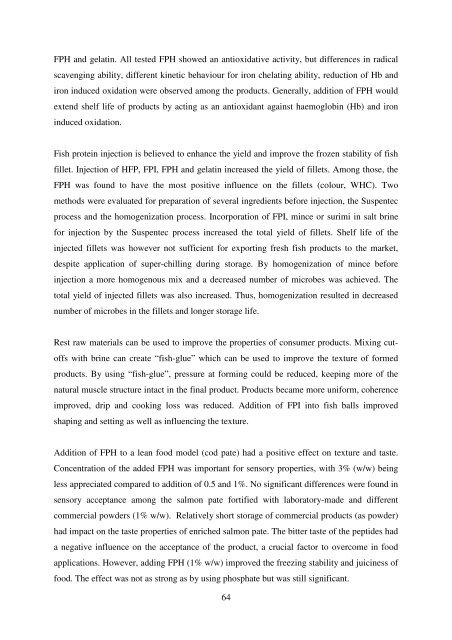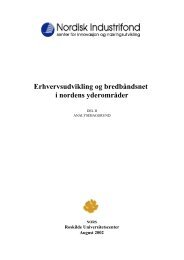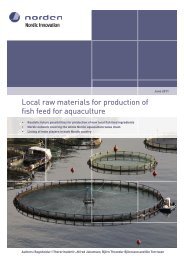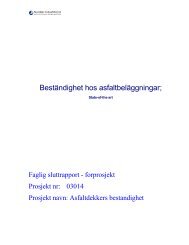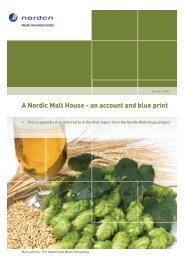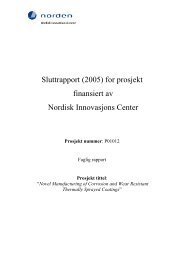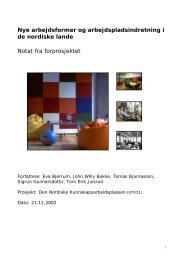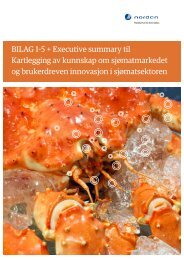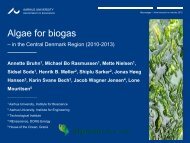Value added fish by-products - Nordic Innovation
Value added fish by-products - Nordic Innovation
Value added fish by-products - Nordic Innovation
You also want an ePaper? Increase the reach of your titles
YUMPU automatically turns print PDFs into web optimized ePapers that Google loves.
FPH and gelatin. All tested FPH showed an antioxidative activity, but differences in radical<br />
scavenging ability, different kinetic behaviour for iron chelating ability, reduction of Hb and<br />
iron induced oxidation were observed among the <strong>products</strong>. Generally, addition of FPH would<br />
extend shelf life of <strong>products</strong> <strong>by</strong> acting as an antioxidant against haemoglobin (Hb) and iron<br />
induced oxidation.<br />
Fish protein injection is believed to enhance the yield and improve the frozen stability of <strong>fish</strong><br />
fillet. Injection of HFP, FPI, FPH and gelatin increased the yield of fillets. Among those, the<br />
FPH was found to have the most positive influence on the fillets (colour, WHC). Two<br />
methods were evaluated for preparation of several ingredients before injection, the Suspentec<br />
process and the homogenization process. Incorporation of FPI, mince or surimi in salt brine<br />
for injection <strong>by</strong> the Suspentec process increased the total yield of fillets. Shelf life of the<br />
injected fillets was however not sufficient for exporting fresh <strong>fish</strong> <strong>products</strong> to the market,<br />
despite application of super-chilling during storage. By homogenization of mince before<br />
injection a more homogenous mix and a decreased number of microbes was achieved. The<br />
total yield of injected fillets was also increased. Thus, homogenization resulted in decreased<br />
number of microbes in the fillets and longer storage life.<br />
Rest raw materials can be used to improve the properties of consumer <strong>products</strong>. Mixing cut-<br />
offs with brine can create “<strong>fish</strong>-glue” which can be used to improve the texture of formed<br />
<strong>products</strong>. By using “<strong>fish</strong>-glue”, pressure at forming could be reduced, keeping more of the<br />
natural muscle structure intact in the final product. Products became more uniform, coherence<br />
improved, drip and cooking loss was reduced. Addition of FPI into <strong>fish</strong> balls improved<br />
shaping and setting as well as influencing the texture.<br />
Addition of FPH to a lean food model (cod pate) had a positive effect on texture and taste.<br />
Concentration of the <strong>added</strong> FPH was important for sensory properties, with 3% (w/w) being<br />
less appreciated compared to addition of 0.5 and 1%. No significant differences were found in<br />
sensory acceptance among the salmon pate fortified with laboratory-made and different<br />
commercial powders (1% w/w). Relatively short storage of commercial <strong>products</strong> (as powder)<br />
had impact on the taste properties of enriched salmon pate. The bitter taste of the peptides had<br />
a negative influence on the acceptance of the product, a crucial factor to overcome in food<br />
applications. However, adding FPH (1% w/w) improved the freezing stability and juiciness of<br />
food. The effect was not as strong as <strong>by</strong> using phosphate but was still significant.<br />
64


